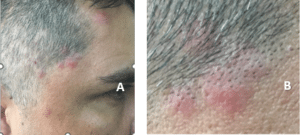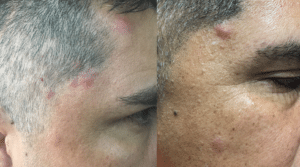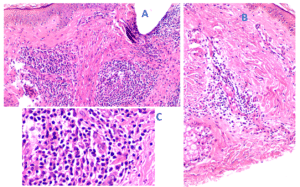Eduardo Garzón Aldás1*, Xavier Garzón Garzón2, Evelyn Janeth Benalcázar Camino3
1Dermatologist and Dermatopathologist, Clinica Dermatologica Garzon, Ecuador
2Medical Resident, Clinica Dermatologica Garzon, Ecuador
3Medical Resident, Clinica Dermatologica Garzon, Ecuador
*Correspondence author: Eduardo Garzón Aldás, Dermatologist and Dermatopathologist, Clinica Dermatologica Garzon, Ecuador; Email: [email protected]
Published Date: 29-07-2023
Copyright© 2023 by Garzón Aldás E, et al. All rights reserved. This is an open access article distributed under the terms of the Creative Commons Attribution License, which permits unrestricted use, distribution, and reproduction in any medium, provided the original author and source are credited.
Abstract
Transient eosinophilic nodulomatosis is an uncommon disease characterized by multiple nodules in different parts of the body, with spontaneous resolution in an average of 3 weeks. Histological examination shows perivascular dermatitis with an inflammatory infiltrate with predominance of eosinophils. The etiopathogenesis has not been well clarified. In this paper we present two new cases of transient eosinophilic nodulomatosis.
Keywords: Eosinophilic; Nodulomatosis; Face; Spontaneously
Introduction
Transient Eosinophilic Nodulomatosis (TEN) is included in the classification of mucosal-cutaneous eosinophilic dermatoses that spontaneously resolve. TEN is described as multiple nodules in different parts of the body, without other manifestations and accompanied or not accompanied by pruritus. The lesions resolve spontaneously over an average of 3 weeks. Histological examination shows superficial and deep perivascular dermatitis with an inflammatory infiltrate with predominance of eosinophils, essentially overlapping with the lesion described by Kuske. TEN has rarely been reported in the literature: There are only two French publications [1,2].
Cases Reports
Case 1
A 40-year-old female patient, who lives in Quito, without a personal or family pathologic history of clinical relevance presented with a cutaneous lesion on the right hemiface associated with pruritus (Fig. 1). She had had the lesion for 4 years, with periods of recurrence and spontaneous improvement without scarring (Fig. 2,3). The patient reported at least five episodes since the onset of the disease with an average duration of 3 weeks. She denied the use of drugs, fillers or facial cosmetics and stated that she had not been bitten by an insect.
Physical examination revealed dermatosis characterized by multiple confluent nodules, which formed an erythematous-violaceous plaque with infiltrated borders and a shiny surface on her right cheek (Fig. 1).
The diagnostic hypotheses were follicular mucinoses, facial granuloma, lymphocytoma, neutrophilic sebaceous adenitis, lupoid leishmaniasis, B-cell lymphoma, angiolymphoid hyperplasia, sarcoidosis, actinic granuloma, facial discoid dermatosis and TEN. The following exams were requested: blood count, blood biochemistry, total IgE, alkaline phosphatase, angiotensin-converting enzyme, HIV serology, VDRL, sediment abnormal elements, stool parasitological examination, chest X-ray and punch biopsy for anatomopathological examination. All tests returned unremarkable findings. Histopathology revealed superficial and deep perivascular eosinophilic dermatitis without significant epidermal changes and without vasculitis (Fig. 4). Based on these clinicopathologic findings, we diagnosed the patient with TEN.

Figure 1: (A) A female patient with nodular lesions on the right cheek. (B) Close up of the erythematous-violaceous plaque formed by the coalescence of nodules (arrows).

Figure 2: A Spontaneous improvement without scarring. B Close up of the involution phase.

Figure 3: (A) Active state of the lesion. (B) Regressive state of the lesion.


Figure 4: A, B, C; A: H-Ex_; Superficial and deep perivascular dermatitis of eosinophilic type without surrounding or involving the dermal and absence of dermal edema; B:H-E lOx intense perivascular inflammatory infiltrate of eosinophilic without vasculitis;C: H-E40x Clouse up of the eosinophilic inflammatory infiltrate.
Case 2
A 43-year-old male patient, who lives in Quito, without a personal or family history of clinical relevance presented with a recurrent pruritic, bilateral, dermatosis located on his face. It had appeared about 6 years ago and there was no evident cause or related external factors. The lesions appear and disappears spontaneously without sequelae. He reported five episodes since the onset of his illness, with each episode lasting approximately 3 weeks. He denied the use of drugs or facial products or that he had been bitten by an insect.
Physical examination revealed bilateral and asymmetric facial dermatosis characterized by nodular, erythematous, urticariform, non-painful lesions, without local heat (Fig. 5,6) and with auto-involutional behavior (Fig. 7). There were no other skin, nail or mucosal alterations.
The diagnostic hypotheses were the same of case 1; we also considered lymphomatoid papulosis. Tests were carried out in the laboratory and revealed normal or negative results, including normal blood chemistry and cell counts, negative HIV, normal autoimmune studies and normal chest X-ray. A punch biopsy sample was taken from one of the lesions; histopathology revealed the same features of the biopsy for case 1 (Fig. 8). Based on the clinical anamnesis, physical examination and histopathological results, we diagnosed the patient with TEN.

Figure 5: (A) Nodular lesions on the right side of the patient’s face; (B) Close up of the nodules.
Figure 6: (A) Nodular lesions on the left side of the patient’s face; (B) Close up of the nodules.

Figure 7: (A) Many nodules in the initial stage; (B) Two weeks later, the patient had fewer nodules.

Figure 8: (A) Intense inflammatory eosinophilic infiltration without vasculitis (hematoxylin and eosin staining, 10×); (B) Deep perivascular eosinophilic infiltration (hematoxylin and eosin staining, 10×); (C) Close up of the inflammatory eosinophilic infiltration (hematoxylin and eosin staining, 40×).
Discussion
Eosinophils are effector cells of the immune response with important affinity for tissues. Skin diseases characterized by dermal infiltration of eosinophils constitute an apparently heterogeneous group [3]. The main dermatoses presenting tissue and peripheral eosinophilia are mostly of allergic, parasitic, neoplastic or autoimmune etiology. Eosinophils are effector cells of the immune response in the antiparasitic defense and have antitumor activity. They have phagocytic activity, can ingest microorganisms and destroy them, but their essential role is the elimination of biological targets such as helminths, protozoa, bacteria and tumor cells. Eosinophils participate in mucosal immune defense and have also been shown in-vitro to possess potent antiviral activity, including the ability to inhibit RNA virus infections [4].
There are five primary eosinophilic diseases: Eosinophilic Pustular Folliculitis (EPF), Eosinophilic Cellulitis (EC), Angiolymphoid Hyperplasia with Eosinophilia (ALHE), Granuloma Faciale (GF) and eosinophilic ulcer of the oral mucosa (EU). TEN is described within the self-involutional mucocutaneous eosinophilic dermatoses [3]. EU, Kuske’s pseudotumor and TEN have many common aspects, but they show clinical differences. For example, EU only presents in the oral cavity (tongue) with a unique ulcer lesion and spontaneous resolution [3]. In TEN, we can see multiple nodules in different corporal zones, without compromise of the oral cavity [3]; these nodules can coalesce and form infiltrated plaques, as in case 1. In addition, TEN has a spontaneous resolution. Finally, for Kuske’s pseudotumor, also known as pseudotumoral eosinophilic granuloma of the skin researchers have proposed a series of clinical criteria for its diagnosis: a firm skin tumor suggestive of malignancy; spontaneous regression in months; not preceded by infection; superficial and deep dermal eosinophils, neutrophils and epithelioid and foamy histiocytes; and negative staining for bacteria, mycobacteria or fungi [3]. The main anatomic zone of presentation is on the back of the hand. The etiopathogenesis has not yet been determined [2].
TEN is described as multiple nodules in different parts of the body, without other manifestations and accompanied or not accompanied by pruritus. The lesions resolve spontaneously, on average, over 3 weeks, a course that occurred in our two cases. Histological examination usually reveals a superficial and deep perivascular dermatitis of eosinophils, without vasculitis and some inflammation, depending on the intensity of the eosinophilic infiltration [3]. The histological hallmark of EU, Kuske’s pseudotumor and TEN is similar: dense dermal infiltrates with a predominance of eosinophils. For this reason, researchers have proposed that these three pathologies are different manifestations of the same disease [2,3].
We diagnosed TEN in our patients due to high clinical suspicion based on the main characteristics: self-involution of the lesions and the histological finding of a predominantly eosinophilic dermatosis. In the first case there was coalescence of multiple nodules about 0.5 cm in diameter that generated an infiltrative plaque, similarly to ALHE. However, AHLE does not show spontaneous resolution of the plaques and the histology is different, with marked vascular involvement as well as lymphocytic infiltration.
TEN is rarely reported in the literature: There have been only two French publications [1,2]. Thus, our report represents an important contribution to the literature. It is crucial to mention that there are no more than four articles about TEN in the literature. Hence, many questions remain to be answered.
Conflict of Interest
The authors have no conflict of interest to declare.
References
- Combemale P, Chouvet B, Dupin M, Guennoa B. Nodulose éosinophilique transitoire. Ann Dermatol Venereol. 1995;122(Suppl 1):13.
- Thivolet J, Pierini AM, Hermier C. Nodulomatose éosinophilique transitoire. Ann Dermatol Venereol. 1980;107:876886.
- Rodríguez Díaz E, Álvarez Cuesta C, Blanco Barrios S, Galache Osuna C, Requena Caballero C. Eosinophilic dermatoses. Actas Dermosifiliogr. 2003;94(2):65-79.
- Domachowske JB, Rosenberg HF. Eosinophils inhibit retroviral transduction of human target cells by a ribonuclease-dependent mechanism. J Leukoc Biol. 1997;62(3):363-8.
Article Type
Case Report
Publication History
Received Date: 28-06-2023
Accepted Date: 22-07-2023
Published Date: 29-07-2023
Copyright© 2023 by Garzón Aldás E, et al. All rights reserved. This is an open access article distributed under the terms of the Creative Commons Attribution License, which permits unrestricted use, distribution, and reproduction in any medium, provided the original author and source are credited.
Citation: Garzón Aldás E, et al. Transient Eosinophilic Nodulomatosis: A Report of Two Cases. J Dermatol Res. 2023;4(2):1-6.

Figure 1: (A) A female patient with nodular lesions on the right cheek. (B) Close up of the erythematous-violaceous plaque formed by the coalescence of nodules (arrows).

Figure 2: A Spontaneous improvement without scarring. B Close up of the involution phase.

Figure 3: (A) Active state of the lesion. (B) Regressive state of the lesion.


Figure 4: A, B, C; A: H-Ex_; Superficial and deep perivascular dermatitis of eosinophilic type without surrounding or involving the dermal and absence of dermal edema; B:H-E lOx intense perivascular inflammatory infiltrate of eosinophilic without vasculitis;C: H-E40x Clouse up of the eosinophilic inflammatory infiltrate.

Figure 5: (A) Nodular lesions on the right side of the patient’s face; (B) Close up of the nodules.
Figure 6: (A) Nodular lesions on the left side of the patient’s face; (B) Close up of the nodules.

Figure 7: (A) Many nodules in the initial stage; (B) Two weeks later, the patient had fewer nodules.

Figure 8: (A) Intense inflammatory eosinophilic infiltration without vasculitis (hematoxylin and eosin staining, 10×); (B) Deep perivascular eosinophilic infiltration (hematoxylin and eosin staining, 10×); (C) Close up of the inflammatory eosinophilic infiltration (hematoxylin and eosin staining, 40×).


